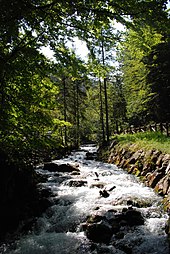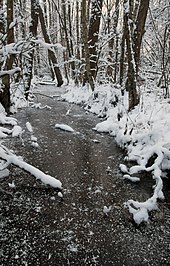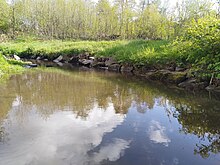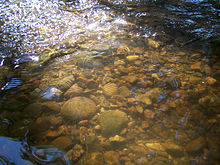Stream
It has been suggested thatPerennial streambemergedinto this article. (Discuss)Proposed since December 2023. |




Astreamis a continuousbodyofsurface water[1]flowingwithin thebedandbanksof achannel.Depending on its location or certain characteristics, a stream may be referred to by a variety of local or regional names. Long, large streams are usually calledrivers,while smaller, less voluminous and moreintermittentstreams are known asstreamlets,brooksorcreeks.
The flow of a stream is controlled by three inputs –surface runoff(fromprecipitationormeltwater),daylightedsubterranean water,and surfacedgroundwater(spring water). The surface and subterranean water are highly variable between periods of rainfall. Groundwater, on the other hand, has a relatively constant input and is controlled more by long-term patterns of precipitation.[2]The stream encompasses surface, subsurface and groundwater fluxes that respond to geological, geomorphological, hydrological and biotic controls.[3]
Streams are important as conduits in thewater cycle,instruments ingroundwater recharge,and corridors for fish and wildlife migration. The biologicalhabitatin the immediate vicinity of a stream is called ariparian zone.Given the status of the ongoingHolocene extinction,streams play an importantcorridorrole in connectingfragmented habitatsand thus in conservingbiodiversity.The study of streams andwaterwaysin general is known assurfacehydrologyand is a core element ofenvironmental geography.[4]
Types[edit]




Brook[edit]
Abrookis a stream smaller than a creek, especially one that is fed by aspringorseep.It is usually small and easilyforded.A brook is characterised by its shallowness.
Creek[edit]
A creek (/kriːk/) or crick (/krɪk/):[5][6]
- InAustralia,Canada,New Zealandand theUnited States,a (narrow) stream that is smaller than a river; a minor tributary of a river; a brook.[12]Sometimes navigable by water craft and may be intermittent.
- In theUnited Kingdom,India,and parts ofMaryland,New England,[13]atidalinlet,typically in asalt marshormangrove swamp,or between enclosed and drained former salt marshes or swamps (e.g.Portsbridge CreekseparatingPortsea Islandfrom the mainland). In these cases, the "stream" is the tidal stream, the course of theseawaterthrough thecreekchannel at low and high tide.
In hydrography,gutis a small creek;[14]this is seen in proper names in eastern North America from the Mid-Atlantic states (for instance,The Gutin Pennsylvania,Ash Gutin Delaware,[15]and other streams)[16]down into the Caribbean (for instance,Guinea Gut,Fish Bay Gut,Cob Gut,Battery Gutandother rivers and streamsin theUnited States Virgin Islands,in Jamaica (Sandy Gut,[17]Bens Gut River,[18]White Gut River), and inmany streams and creeksof theDutch Caribbean).[19]
River[edit]
Ariveris a large natural stream that is much wider and deeper than a creek and not easily fordable, and may be anavigablewaterway.[20]
Runnel[edit]
The linear channel between the parallel ridges orbarson a shoreline beach or river floodplain, or between a bar and the shore. Also called aswale.
Tributary[edit]
Atributaryis a contributory stream to a larger stream, or a stream which does not reach a staticbody of watersuch as alake,bayorocean[21]but joins another river (a parent river). Sometimes also called a branch or fork.[22]
Distributary[edit]
A distributary, or a distributary channel, is a stream that branches off and flows away from a main stream channel, and the phenomenon is known asriver bifurcation.Distributaries are common features ofriver deltas,and are often found where avalleyedstream enters wideflatlandsor approaches thecoastal plainsaround alakeor anocean.They can also occur inland, onalluvial fans,or where a tributary stream bifurcates as it nears itsconfluencewith a larger stream. Common terms for individual river distributaries inEnglish-speaking countriesarearmandchannel.
Other names[edit]
There are a number of regional names for a stream.
Northern America[edit]
- Branchis used to name streams in Maryland and Virginia.[23]
- Creekis common throughout the United States, as well as Australia.
- Fallsis also used to name streams in Maryland, for streams/rivers which have waterfalls on them, even if such falls only have a small vertical drop.Little Gunpowder Fallsand theJones Fallsare actually rivers named in this manner, unique to Maryland.[citation needed]
- KillinNew York,Pennsylvania,Delaware,andNew Jerseycomes from aDutch languageword meaning "riverbed" or "water channel", and can also be used for the UK meaning of 'creek'.
- RuninOhio,Maryland,Michigan,New Jersey, Pennsylvania, Virginia, or West Virginia can be the name of a stream.[24]
- RuninFloridais the name given to streams coming out of small natural springs.[25]Riveris used for streams from larger springs like theSilver RiverandRainbow River.
- Streamandbrookare used inMidwestern states,Mid-Atlantic states,andNew England.[24]
United Kingdom[edit]
- Alltis used in theScottish Highlands.[citation needed]
- Beckis used inLincolnshiretoCumbriain areas which were once occupied by the Danes and Norwegians.[26]
- Bourneorwinterbourneis used in the chalkdownlandof southern England for ephemeral rivers.[27]When permanent, they arechalk streams.
- Brook.[28]
- Burnis used in Scotland andNorth East England.[29]
- Gillorghyllis seen in the north of England andKentandSurreyinfluenced byOld Norse.The variant "ghyll" is used in theLake Districtand appears to have been an invention ofWilliam Wordsworth.[30]
- Nantis used in Wales.[31]
- Rivuletis a term encountered inVictorian erapublications.[32]
- Sykeis used in theScottish Lowlandsand Cumbria for a seasonal stream.[33]
Related terminology[edit]
- Bar
- A shoal that develops in a stream as sediment is deposited as the current slows or is impeded by wave action at the confluence.
- Bifurcation
- A fork into two or more streams.
- Channel
- A depression created by constanterosionthat carries the stream's flow.
- Confluence
- The point at which the two streams merge. If the two tributaries are of approximately equal size, the confluence may be called a fork.
- Drainage basin
- (also known as awatershedin the United States) The area of land where water flows into a stream. A large drainage basin such as theAmazon Rivercontains many smaller drainage basins.[34]
- Floodplain
- Lands adjacent to the stream that are subject tofloodingwhen a stream overflows its banks.[34]
- Headwatersor source
- The part of a stream or river proximate to its source. The word is most commonly used in the plural where there is no singlepoint source.[34]
- Knickpoint
- The point on a stream's profile where a sudden change instream gradientoccurs.
- Mouth
- The point at which the stream discharges, possibly via anestuaryor delta, into a static body of water such as a lake or ocean.
- Pool
- A segment where the water is deeper and slower moving.
- Rapids
- Aturbulent,fast-flowing stretch of a stream or river.
- Riffle
- A segment where the flow is shallower and moreturbulent.
- River
- A large natural stream, which may be awaterway.[34]
- Run
- A somewhat smoothly flowing segment of the stream.
- Spring
- The point at which a stream emerges from an underground course through unconsolidatedsedimentsor through caves. A stream can, especially with caves, flow aboveground for part of its course, and underground for part of its course.[34]
- Stream bed
- The bottom of a stream.
- Stream corridor
- Stream, its floodplains, and the transitional upland fringe[35]
- Streamflow
- The water moving through a stream channel.[34]:Stream gauge:A site along the route of a stream or river, used for reference marking or water monitoring.[34]
- Thalweg
- The river's longitudinal section, or the line joining the deepest point in the channel at each stage from source to mouth.
- Watercourse
- The channel followed by a stream (a flowing body of water)[36]or the stream itself.[37][38][39]In the UK, some aspects of criminal law, such as the Rivers (Prevention of Pollution) Act 1951, specify that a watercourse includes those rivers which aredry for part of the year.[40]In some jurisdictions, owners of land over which the water flows may have the legal right to use or retain some or much of that water.[41]This right may extend to estuaries, rivers, streams,anabranches[42]andcanals.[43]
- Waterfallor cascade
- The fall of water where the stream goes over a sudden drop called a knickpoint; some knickpoints are formed by erosion when water flows over an especially resistantstratum,followed by one less so. The stream expendskinetic energyin "trying" to eliminate the knickpoint.
- Wetted perimeter
- The line on which the stream's surface meets the channel walls.
Sources[edit]


A stream's source depends on the surrounding landscape and its function within larger river networks. While perennial and intermittent streams are typically supplied by smaller upstream waters and groundwater, headwater and ephemeral streams often derive most of their water from precipitation in the form of rain and snow.[44]Most of this precipitated water re-enters the atmosphere byevaporationfrom soil and water bodies, or by theevapotranspirationof plants. Some of the water proceeds to sink into the earth byinfiltrationand becomes groundwater, much of which eventually enters streams. Some precipitated water is temporarily locked up in snow fields andglaciers,to be released later by evaporation or melting. The rest of the water flows off the land as runoff, the proportion of which varies according to many factors, such as wind, humidity, vegetation, rock types, and relief. This runoff starts as a thin film called sheet wash, combined with a network of tiny rills, together constituting sheet runoff; when this water is concentrated in a channel, a stream has its birth. Some creeks may start from ponds or lakes.

Characteristics[edit]
Ranking[edit]
To qualify as a stream, a body of water must be either recurring or perennial. Recurring (intermittent) streams have water in the channel for at least part of the year. A stream of thefirst orderis a stream which does not have any other recurring or perennial stream feeding into it. When two first-order streams come together, they form a second-order stream. When two second-order streams come together, they form a third-order stream. Streams of lower order joining a higher order stream do not change the order of the higher stream.
Gradient[edit]
Thegradientof a stream is a critical factor in determining its character and is entirely determined by itsbase levelof erosion. The base level of erosion is the point at which the stream either enters the ocean, a lake or pond, or enters a stretch in which it has a much lower gradient, and may be specifically applied to any particular stretch of a stream.
In geological terms, the stream will erode down through its bed to achieve the base level of erosion throughout its course. If this base level is low, then the stream will rapidly cut through underlying strata and have a steep gradient, and if the base level is relatively high, then the stream will form a flood plain and meander.
Profile[edit]
Typically, streams are said to have a particularelevation profile,beginning with steep gradients, no flood plain, and little shifting of channels, eventually evolving into streams with low gradients, wide flood plains, and extensive meanders. The initial stage is sometimes termed a "young" or "immature" stream, and the later state a "mature" or "old" stream.
Meander[edit]
Meandersare looping changes of direction of a stream caused by the erosion and deposition of bank materials. These are typically serpentine in form. Typically, over time the meanders gradually migrate downstream. If some resistant material slows or stops the downstream movement of a meander, a stream may erode through the neck between two legs of a meander to become temporarily straighter, leaving behind an arc-shaped body of water termed anoxbow lakeorbayou.A flood may also cause a meander to be cut through in this way.
Stream load[edit]
Thestream loadis defined as the solid matter carried by a stream. Streams can carry sediment, or alluvium. The amount of load it can carry (capacity) as well as the largest object it can carry (competence) are both dependent on thevelocityof the stream.
Classification[edit]
Perennial or not[edit]
Aperennial streamis one which flows continuously all year.[45]: 57 Some perennial streams may only have continuous flow in segments of its stream bed year round during years of normal rainfall.[46][47]Blue-line streams are perennial streams and are marked ontopographic mapswith a solid blue line.
Ephemeral stream[edit]
Generally, streams that flow only during and immediately after precipitation are termedephemeral.There is no clear demarcation between surface runoff and an ephemeral stream,[45]: 58 and some ephemeral streams can be classed as intermittent—flow all but disappearing in the normal course of seasons but ample flow (backups) restoring stream presence — such circumstances are documented when stream beds have opened up a path into mines or other underground chambers.[48]
According to official U.S. definitions, the channels of intermittent streams are well-defined,[49]as opposed to ephemeral streams, which may or may not have a defined channel, and rely mainly on storm runoff, as their aquatic bed is above thewater table.[50]An ephemeral stream does not have the biological, hydrological, and physical characteristics of a continuous or intermittent stream.[50]The same non-perennial channel might change characteristics from intermittent to ephemeral over its course.[50]
Intermittent or seasonal stream[edit]


Washes can fill up quickly during rains, and there may be a sudden torrent of water after athunderstormbegins upstream, such as duringmonsoonalconditions. In the United States, anintermittentorseasonal streamis one that only flows for part of the year and is marked on topographic maps with a line of blue dashes and dots.[45]: 57–58 Awash,desert wash, or arroyois normally a dry streambed in thedesertsof theAmerican Southwest,which flows after sufficient rainfall.
In Italy, an intermittent stream is termed atorrent(Italian:torrente). In full flood the stream may or may not be "torrential" in the dramatic sense of the word, but there will be one or more seasons in which the flow is reduced to a trickle or less. Typically torrents haveApenninerather thanAlpinesources, and in the summer they are fed by little precipitation and no melting snow. In this case the maximum discharge will be during the spring and autumn.
An intermittent stream can also be called awinterbournein Britain, awadiin theArabic-speaking world or torrente orrambla(this last one from arabic origin) in Spain and Latin America. In Australia, an intermittent stream is usually called a creek and marked on topographic maps with a solid blue line.[citation needed]
Consequential or not[edit]
There are five generic classifications:
- Consequentstreams are streams whose course is a direct consequence of the original slope of the surface[51]upon which it developed, i.e., streams that follow slope of the land over which they originally formed.
- Subsequentstreams are streams whose course has been determined by selectiveheadward erosionalong weak strata. These streams have generally developed after the original stream. Subsequent streams developed independently of the original relief of the land and generally follow paths determined by the weak rock belts.
- Resequentstreams are streams whose course follows the original relief, but at a lower level than the original slope (e.g., flows down a course determined by the underlying strata in the same direction). These streams develop later and are generally a tributary to a subsequent stream.[52]
- Obsequentstreams are streams flowing in the opposite direction of the consequent drainage.
- Insequentstreams have an almost random drainage often forming dendritic patterns. These are typically tributaries and have developed by a headward erosion on a horizontally stratified belt or on homogeneous rocks. These streams follow courses that apparently were not controlled by the original slope of the surface, its structure or the type of rock.
Drainage basins[edit]
The extent of land basin drained by a stream is termed its drainage basin (also known in North America as the watershed and, in British English, as a catchment).[53]A basin may also be composed of smaller basins. For instance, theContinental Dividein North America divides the mainly easterly-draining Atlantic Ocean and Arctic Ocean basins from the largely westerly-flowing Pacific Ocean basin. The Atlantic Ocean basin, however, may be further subdivided into the Atlantic Ocean and Gulf of Mexico drainages. (This delineation is termed theEastern Continental Divide.) Similarly, the Gulf of Mexico basin may be divided into theMississippi Riverbasin and several smaller basins, such as theTombigbee Riverbasin. Continuing in this vein, a component of the Mississippi River basin is theOhio Riverbasin, which in turn includes theKentucky Riverbasin, and so forth.
Crossings[edit]
Stream crossingsare where streams are crossed byroads,pipelines,railways,or any other thing which might restrict the flow of the stream in ordinary or flood conditions. Any structure over or in a stream which results in limitations on the movement of fish or other ecological elements may be an issue.
See also[edit]
- Aqueduct (water supply)
- Environmental flow
- Fluvial sediment processes
- Head cut
- Playfair's Law
- River ecosystem
- Rock-cut basin
- Tidal stream generator
References[edit]
- ^Langbein, W.B.; Iseri, Kathleen T. (1995)."Hydrologic Definitions: Stream".Manual of Hydrology: Part 1. General Surface-Water Techniques(Water Supply Paper 1541-A). Reston, VA: USGS.Archivedfrom the original on 2012-05-09.
- ^Basic Biology (16 January 2016)."River".
- ^Alexander, L. C., Autrey, B., DeMeester, J., Fritz, K. M., Golden, H. E., Goodrich, D. C.,... & McManus, M. G. (2015).Connectivity of streams and wetlands to downstream waters: review and synthesis of the scientific evidence(Vol. 475). EPA/600/R-14.
- ^"What is hydrology and what do hydrologists do?"Archived2014-02-22 at theWayback MachineU.S. Geological Survey (USGS). Atlanta, GA. 2009-05-13.
- ^"creek".dictionary.Dictionary, LLC.Retrieved16 May2019.
kreek, krik
- ^"crick".English Oxford Living Dictionaries.Oxford University Press.Archived fromthe originalon May 18, 2019.Retrieved18 May2019.
Northern, North Midland, and Western U.S.
- ^"creek".oxforddictionaries.Oxford University Press. Archived fromthe originalon September 24, 2016.Retrieved18 May2019.
British...especially an inlet...(whereas) NZ, North American, Australian...stream or minor tributary.
- ^"(US) creek".English Oxford Living Dictionaries.Oxford University Press. Archived fromthe originalon September 24, 2016.Retrieved18 May2019.
North American, Australian, NZ...A stream, brook, or minor tributary of a river.
- ^"creek".Dictionary.Dictionary, LLC.Retrieved18 May2019.
U.S., Canada, and Australia…a stream smaller than a river.
- ^"creek".Collins Dictionary.Retrieved18 May2019.
US, Canadian, Australian and New Zealand a small stream or tributary
- ^"creek".Macmillan Dictionary.Springer Nature Limited.Retrieved18 May2019.
a narrow stream
- ^[7][8][9][10][11]
- ^Spruce Creek Association. Kittery, ME."About the Spruce Creek Watershed."Archived2008-07-03 at theWayback MachineAccessed 2010-10-02.
- ^"Gut (definition)".Merriam-Webster Dictionary.RetrievedAugust 8,2014.
- ^"Ash Gut".Anyplace America.RetrievedAugust 14,2014.
- ^"Feature Query Results".Geographic Names Information System (GNIS).United States Geological Survey.RetrievedAugust 14,2014.
- ^"Sandy Gut, Jamaica".iTouch Map.RetrievedAugust 9,2014.
- ^"Bens Gut River".Geoview.RetrievedAugust 9,2014.
- ^"White Gut River (Jamaica)".Gazettering.RetrievedAugust 9,2014.
- ^Wetzel, Robert G. (2001).Limnology: Lake and river ecosystems(3rd ed.). San Diego: Academic Press.ISBN978-0127447605.OCLC46393244.
- ^Krebs, Robert E. (2003).The Basics of Earth Science.Greenwood Publishing Group.ISBN978-0-313-31930-3.
- ^Bisson, Peter and Wondzell, Steven."Olympic Experimental State Forest Synthesis of Riparian Research and Monitoring"Archived2022-08-13 at theWayback Machine,United States Forest Service,p. 15 (December 1, 2009).
- ^"OED Online -Branch".Oxford University Press. June 2017.Retrieved6 July2017.
- ^ab"Derek Watkin's USGS Analysis".25 July 2011.Retrieved26 November2018.
- ^Steigerwalt, Nancy M.; Cichra, Charles E.; Baker, Shirley M. (2008). "Composition and Distribution of Aquatic Invertebrate Communities on Snags in a North Central Florida, USA, Spring-Run Stream".Florida Scientist.71(3): 273–286.JSTOR24321406.
- ^"OED Online – Beck".Oxford University Press. June 2017.Retrieved6 July2017.
- ^"OED Online – Bourne".Oxford University Press. June 2017.Retrieved6 July2017.
- ^"OED Online – Brook".Oxford University Press. June 2017.Retrieved6 July2017.
- ^"OED Online – Burn".Oxford University Press. June 2017.Retrieved6 July2017.
- ^"OED Online – Gill".Oxford University Press. June 2017.Retrieved6 July2017.
- ^"OED Online – Nant".Oxford University Press. June 2017.Retrieved6 July2017.
- ^"OED Online – Rivulet".Oxford University Press. June 2017.Retrieved6 July2017.
- ^"OED Online – Sike".Oxford University Press. June 2017.Retrieved6 July2017.
- ^abcdefg"USGS Water Science Glossary of Terms".United States Geological Survey. 26 November 2018.
- ^"Stream Corridor Structure"Archived2015-04-02 at theWayback MachineAdapted fromStream Corridor Restoration: Principles, Processes, and Practices
- ^Shannonhouse, Royal G. (1961). "Some Principles of Water Law in the Southeast".Mercer Law Review.13:344.
- ^"Definition of WATERCOURSE".Merriam-Webster.2022-03-18.Retrieved2022-04-05.
- ^"watercourse".definition in the Cambridge English Dictionary.2016-03-07.Retrieved2022-04-05.
- ^Lewis, Roy; Hilton, John Buxton; Fallon, Jennifer (2022-04-05)."Watercourse definition and meaning".Collins English Dictionary.Retrieved2022-04-05.
- ^"Rivers (Prevention of Pollution) Act 1951".legislation.gov.uk.Retrieved25 August2016.
- ^Jones, J.G. (1965). "Water Rights in Louisiana".Louisiana Law Review.16(3): 500.
- ^North, Colin P. (2007)."Recognition of the Sedimentary Architecture of Dryland Anabranching (Anastomosing) Rivers".Journal of Sedimentary Research.77(11): 925–938.Bibcode:2007JSedR..77..925N.doi:10.2110/jsr.2007.089.
- ^"Watercourse".FEMA.Archived fromthe originalon 2017-07-07.Retrieved2017-12-15.
- ^"Streams | Rivers & Streams | US EPA".archive.epa.gov.Retrieved2021-10-14.
- ^abcMeinzer, Oscar E. (1923).Outline of ground-water hydrology, with definitions.Washington, DC: USGS.doi:10.3133/wsp494.Archivedfrom the original on 2017-07-09.Water Supply Paper 494.
- ^Meinzer, Oscar E. (1923).Outline of ground-water hydrology, with definitions.Washington, DC: US Geological Survey (USGS). p. 57.doi:10.3133/wsp494.Archivedfrom the original on 2017-07-09.Water Supply Paper 494.
- ^"OSM – COALEX State Inquiry Report 97".Archivedfrom the original on 2012-04-15.Retrieved2011-12-11.
- ^Black Creek (Susquehanna River)#Hydrology and climate,'Black Creek is an ephemeral stream. It used to drain an area between Turtle Creek and the Susquehanna River, but now loses its flow to underground mines via broken bedrock. Its channel is also disrupted by strip mines and rock piles.',14 Nov 2016.
- ^"2. EVALUATING THE BIOLOGICAL SIGNIFICANCE OF INTERMITTENT STREAMS".fs.fed.us.Retrieved2020-05-18.
- ^abc"Stream Identification Method and Rating Form: Definitions".Identification Methods for the Origins of Intermittent and Perennial streams, Version 3.1(PDF).North Carolina Department of Environment and Natural Resources, Division of Water Quality. 28 February 2005. p. 2.Retrieved28 February2021.
- ^"consequent stream".Dictionary.Retrieved2008-04-24.
- ^"Definition of RESEQUENT".merriam-webster.Retrieved2022-12-14.
- ^Langbein, W.B.; Iseri, Kathleen T. (1995)."Hydrologic Definitions: Watershed".Manual of Hydrology: Part 1. General Surface-Water Techniques(Water Supply Paper 1541-A). Reston, VA: USGS.Archivedfrom the original on 2012-05-09.
External links[edit]
- Glossary of stream-related terms,StreamNet
